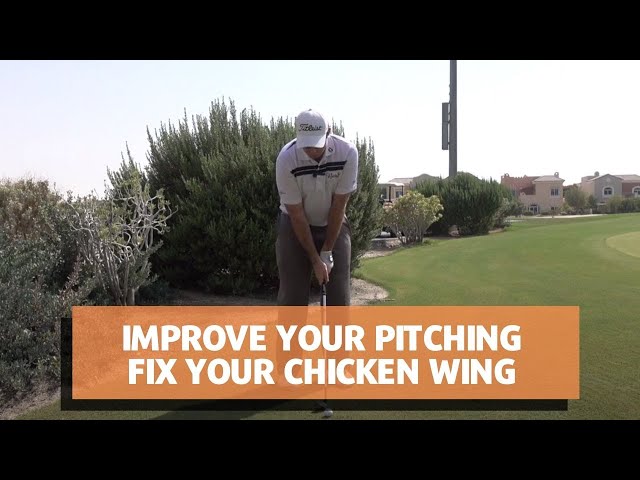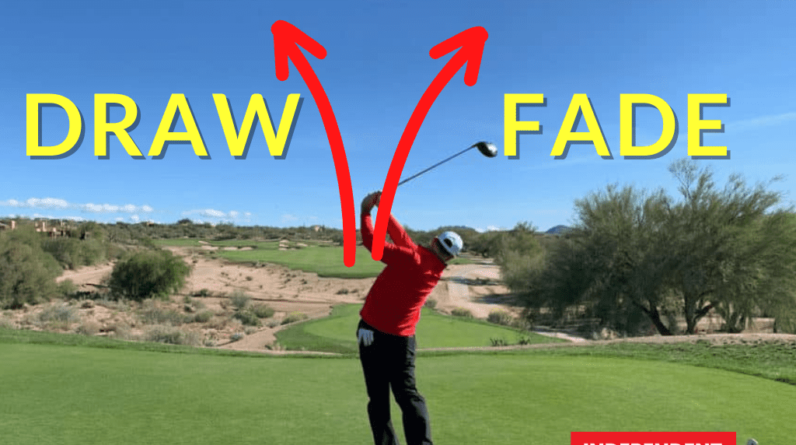Have you ever found yourself frustrated by the infamous “chicken wing” in your golf swing? You know, when your lead arm bends instead of staying straight through impact, resulting in less power and accuracy? Well, fear not, because in this article, you’ll discover some helpful tips and techniques to fix this common problem and improve your swing. So, grab your club and let’s get ready to eliminate that pesky chicken wing once and for all!
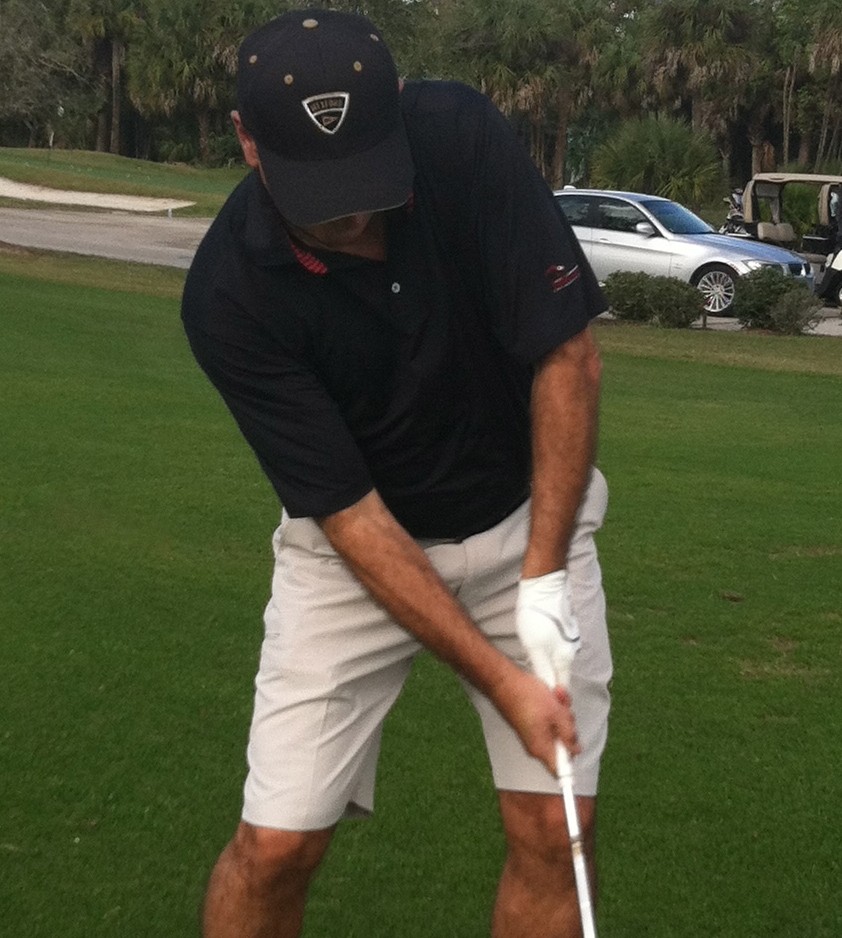
Common Causes of the Chicken Wing
The “chicken wing” refers to a golfer’s arm position during the swing, where the lead arm bends instead of extending fully. This can lead to various issues in your swing and hinder your overall performance. Understanding the common causes of the chicken wing can help you identify and address the problem effectively.
Improper grip
One of the main causes of the chicken wing is an improper grip. If your grip is too strong or too weak, it can affect the alignment of your arms during the swing. Your grip should be neutral, with both hands working together to promote better extension and follow-through.
Lack of shoulder rotation
Inadequate shoulder rotation is another factor that can contribute to the chicken wing. Failing to rotate your shoulders fully during the backswing and follow-through can restrict the movement of your arms and lead to the dreaded chicken wing position.
Incorrect body positioning
Your body position plays a crucial role in maintaining a proper swing. If you have incorrect body positioning, such as leaning too far forward or standing too upright, it can compromise the extension of your arms and contribute to the chicken wing.
Poor follow-through
A poor follow-through is often associated with the chicken wing. If you don’t properly extend your arms and finish the swing, it can cause your lead arm to collapse, resembling a chicken wing. A strong, full follow-through is essential for a complete and fluid swing motion.
Effects of the Chicken Wing
Understanding the effects of the chicken wing can highlight the importance of addressing this issue in your golf swing. Let’s explore the consequences of the chicken wing position.
Loss of power
When you chicken wing, you restrict the extension of your lead arm, leading to a loss of power in your swing. The chicken wing position prevents the clubhead from accelerating fully, resulting in reduced clubhead speed and a weaker impact on the ball.
Inconsistent ball striking
The chicken wing can significantly affect your ball striking consistency. With improper arm extension, it becomes challenging to strike the ball consistently in the desired direction. Your shots may vary in terms of distance, accuracy, and trajectory, making it difficult to achieve the desired results.
Lack of control
Maintaining control over your shots is essential for a successful golf game. The chicken wing can compromise your control over the clubhead and the impact on the ball. It becomes harder to shape shots or adjust for different course conditions, diminishing your ability to play with precision.
Higher chance of injury
The chicken wing position can also increase the risk of injury. When your lead arm collapses and doesn’t extend fully, it puts strain on your muscles, tendons, and joints. Over time, this can lead to discomfort, pain, and potential injuries in your shoulder, elbow, or wrist.
Improving Shoulder Rotation
Improving shoulder rotation is crucial for correcting the chicken wing and fostering a better swing. Incorporate the following exercises into your routine to enhance your shoulder rotation.
Stretching exercises
Performing stretching exercises specifically designed for the shoulders can improve their flexibility and range of motion. Focus on stretches that target the rotator cuff muscles and the muscles in your upper back and chest. Gentle stretches before your golf practice or round can help prepare your shoulders for optimal rotation.
Range of motion exercises
Engaging in range of motion exercises can gradually increase the flexibility and mobility of your shoulders. These exercises involve moving your arms in different directions, such as internal and external rotation, abduction, and adduction. Incorporate these exercises into your warm-up or as part of a dedicated shoulder mobility routine.
Resistance training
Strengthening the muscles involved in shoulder rotation can significantly improve your ability to rotate effectively during the swing and avoid the chicken wing. Incorporate resistance training exercises such as rows, lateral raises, and shoulder presses into your workout routine. Focus on maintaining proper form and gradually increase the resistance as your strength improves.
Correcting Grip
Addressing your grip is essential in fixing the chicken wing. Adopting a proper grip can help promote better extension and fluid motion in your swing. Consider the following techniques to correct your grip.
Neutral grip
A neutral grip involves positioning your hands on the club in a way that promotes better wrist hinge and arm extension. To achieve a neutral grip, place the club in your left hand (for right-handed golfers) so that it rests diagonally across the base of your fingers. Then, interlock or overlap the pinky finger of your right hand with the index finger of the left hand. This grip encourages a natural release of the club and minimizes the chances of a chicken wing.
Proper hand positioning
In addition to a neutral grip, focus on proper hand positioning throughout your swing. Avoid excessive tension in your hands and wrists, as it can restrict the movement of your arms. Keep your hands relaxed, ensuring that the back of your top hand faces the target at impact, promoting better extension and reducing the likelihood of a chicken wing.
Grip pressure
Finding the right balance of grip pressure can also influence your arm extension during the swing. Avoid gripping the club too tightly, as it can cause tension in your arms and restrict their movement. Maintain a light to moderate grip pressure, allowing for a more natural release and follow-through, reducing the chances of a chicken wing.
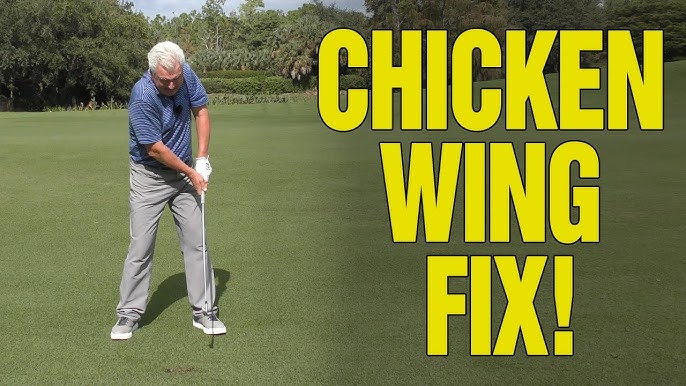
Fixing Body Positioning
Your body positioning throughout the swing plays a significant role in avoiding the chicken wing. By addressing your alignment, posture, and overall awareness of your body during the swing, you can improve your chances of executing a proper extension. Try the following strategies to fix your body positioning.
Alignment drills
Practice alignment drills to ensure you’re properly aligned to your target. Use alignment sticks or clubs and position them parallel to your target line. Set up your body with your feet, hips, and shoulders aligned with the sticks. This visual aid can help train your body to maintain the correct position and improve your ability to extend your arms fully through the swing.
Posture adjustments
Evaluate your posture during the setup and adjust it accordingly. A balanced posture allows for a more natural and fluid swing motion. Ensure that your upper body is slightly tilted forward from the hips, maintaining a straight spine. This posture promotes better extension and reduces the likelihood of collapsing the lead arm.
Being aware of body position during the swing
Maintaining awareness of your body position throughout the swing is key to avoiding the chicken wing. Focus on keeping your lead arm extended throughout the downswing and follow-through. Visualize a full extension and dedicate mental energy towards maintaining that position. Developing body awareness and incorporating it into your practice sessions can gradually eliminate the chicken wing tendency.
Developing a Strong Follow-Through
A strong follow-through is crucial in ensuring a complete and proper swing motion. By implementing a full finish and focusing on the follow-through, you can reduce the chances of a chicken wing. Consider the following tips to develop a strong follow-through.
Implementing a full finish
Make it a habit to complete your swing with a full, balanced finish. After striking the ball, continue the motion toward your target and allow your arms to extend naturally. Imagine holding your finish position until the ball has reached its target. This commitment to a full finish encourages proper arm extension and better follow-through.
Training aids for follow-through
Utilize training aids specifically designed to promote a proper follow-through. These aids can help reinforce the feeling and mechanics involved in extending your arms and avoiding a chicken wing. Options include impact bags, alignment poles, and various swing trainers aimed at promoting a full swing and follow-through.
Mental focus on follow-through
Develop a strong mental focus on the follow-through during your practice and rounds. As you swing, consciously dedicate attention to extending your arms fully and maintaining a complete follow-through. Visualize the desired extension and focus on replicating that feeling with every swing. By prioritizing the follow-through, you create a habit that helps eliminate the chicken wing issue.
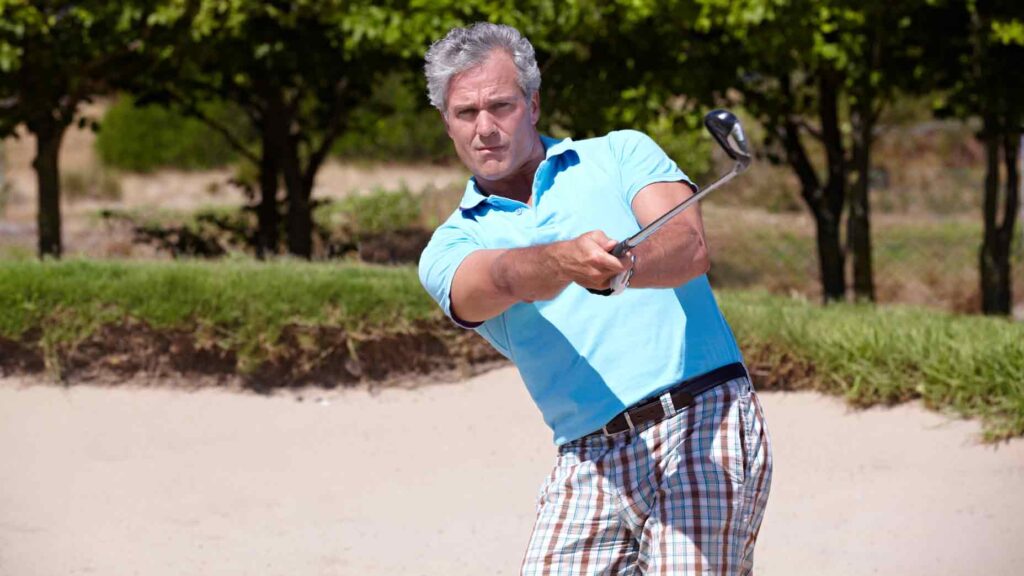
Drills and Practice Techniques
Performing drills and implementing specific practice techniques can accelerate your progress in fixing the chicken wing. Here are a few drills to consider incorporating into your practice sessions.
Arm extension drill
Focus on extending your lead arm fully through impact and beyond. Practice swinging with the intention of extending your arms as far as possible, creating a straight line from your lead shoulder to your club. This drill reinforces the feeling of extension and helps correct any inclination to chicken wing.
One-arm swing drill
Performing one-arm swings can be an effective drill for promoting proper extension and a solid follow-through. By swinging with one arm, you eliminate the possibility of a chicken wing position in the lead arm. Practice swinging with each arm individually to develop a better understanding of extension and follow-through mechanics.
Mirror work
Utilize a mirror to observe your swing technique and monitor the position of your arms throughout the swing. Set up a mirror near your hitting area or practice space and swing while watching your reflection. Pay close attention to the position of your lead arm and ensure it remains extended and straight throughout the swing, avoiding any signs of a chicken wing.
Seeking Professional Assistance
Sometimes, it can be challenging to address swing issues on your own. Seeking professional assistance, such as working with a golf instructor or taking golf lessons, can provide valuable guidance tailored to your specific needs.
Working with a golf instructor
A qualified golf instructor can provide expert analysis of your swing mechanics and identify the root causes of the chicken wing. They can offer personalized instruction and specific drills to help correct your swing and build a solid foundation for improvement. With their guidance, you can accelerate your progress and achieve better results on the course.
Taking golf lessons
Enrolling in golf lessons can be highly beneficial, especially if you’re a beginner or struggling with specific aspects of your swing. Participating in a structured program led by a professional can help you develop proper technique, including avoiding the chicken wing. Lessons offer a progressive learning experience, allowing you to gradually improve your swing mechanics over time.
Video analysis
Video analysis is a valuable tool that golf instructors often use to evaluate and refine a player’s swing. Recording your swing from different angles can provide insight into your arm position, extension, and follow-through. By reviewing the footage with your instructor, you can identify any chicken wing tendencies and work together to find personalized solutions.
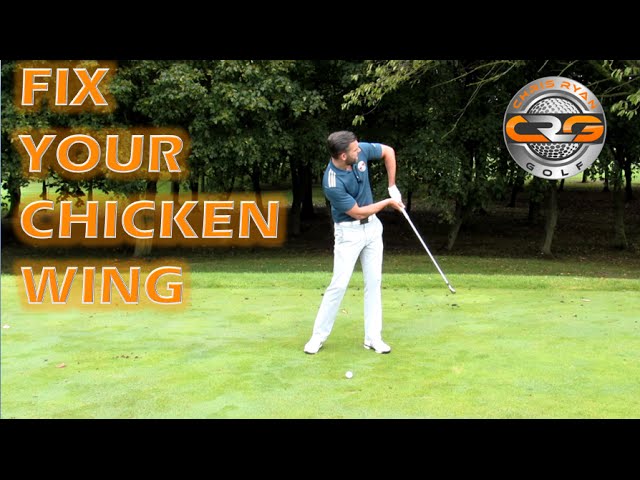
Developing Consistency and Control
Fixing the chicken wing is not only about eliminating a flawed arm position but also about developing consistency and control in your swing. The following strategies can help you achieve a more reliable and controlled swing.
Working on tempo and rhythm
Developing a consistent tempo and rhythm in your swing can greatly improve your overall control. Practice swinging with a consistent cadence, ensuring a smooth transition from backswing to downswing. By maintaining consistent timing and rhythm, you’ll be better equipped to execute a full extension without the tendency to chicken wing.
Practicing with purpose
Approach your practice sessions with a purposeful mindset. Define specific goals and targets for each practice session, focusing on the quality of your swings rather than the quantity. Concentrate on maintaining proper arm extension and follow-through while hitting targets or simulating on-course scenarios. Practicing with intention and mindfulness accelerates improvement and creates muscle memory for correct swing mechanics.
Developing muscle memory
Repetition and consistent practice are key to developing muscle memory in your swing. As you dedicate time to fixing the chicken wing, repeat the correct extension and follow-through motions regularly. Over time, your muscles will become familiar with the correct technique, and the tendency to chicken wing will diminish. Maintain patience, as solidifying muscle memory takes time and repetition.
Preventing Injuries
Addressing the chicken wing not only improves your golf swing but also reduces the risk of injuries associated with the improper arm position. Follow these measures to prevent injuries and protect your body.
Proper warm-up and cool-down
Before engaging in a round of golf or practice session, ensure you perform a proper warm-up to prepare your body for the physical demands of the swing. Include dynamic stretches, light cardio exercises, and mobility drills. After your session, cool down with gentle stretches to help your muscles relax and recover.
Strengthening exercises
Incorporate strength training exercises into your fitness routine to build stability and resilience in your muscles and joints. Focus on exercises that target your core, upper body, and lower body to create a balanced fitness routine. Strong muscles can help support proper swing mechanics and reduce the risk of strain or injury associated with the chicken wing position.
Using proper equipment
Using properly fitted golf clubs can reduce the chances of a chicken wing position. Ensure that your clubs are the right length, have suitable shaft flex, and are suited to your swing speed and style. Ill-fitting equipment can contribute to swing flaws, including the chicken wing. Consult with a professional club fitter to ensure your clubs are optimized for your game.
In conclusion, fixing the dreaded chicken wing in your swing requires a combination of addressing common causes, correcting grip and body positioning, developing a strong follow-through, and putting in deliberate practice. By focusing on improving shoulder rotation, grip, body positioning, and follow-through, you can gradually eliminate the chicken wing tendency and achieve a more powerful, controlled, and injury-free golf swing. Seek professional assistance if needed, practice with purpose, and prioritize the prevention of injuries through warm-ups, strength training, and proper equipment. With dedication and persistence, you can conquer the chicken wing and enhance your golf game.
